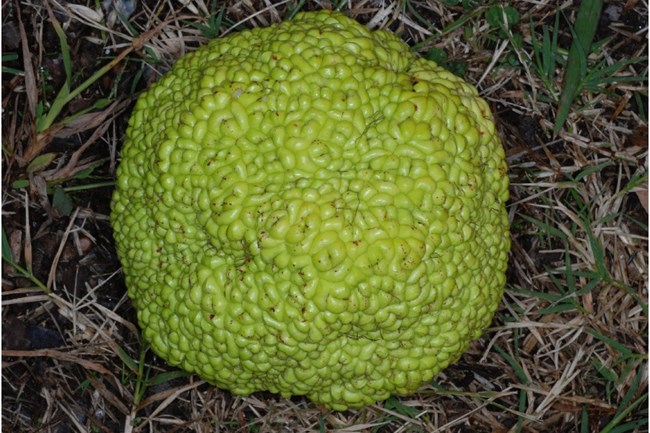Last updated: March 31, 2021
Article
Osage Orange at Homestead National Historical Park

NPS
Specimen Details
- Location: Homestead National Historical Park, Beatrice, Nebraska
- Species: Osage orange (Maclura pomifera)
- Landscape Use: Hedgerow
- Age: Estimated planting 1875
- Condition: Fair to Good (age)
- Measurements:
- Diameter at breast height (DBH): Average 18”
- Height: Average 30’
- Spread: Average 35’
Significance
In ca. 1875-1885, Daniel Freeman planted a three-quarter mile long, Osage orange (Maclura pomifera) hedgerow along the southern boundary of his farm. Besides marking Freeman’s property boundaries and conserving his timber resources, the hedge may have served as windbreak. With the exception of this single hedgerow on the homestead’s southern boundary, however, Freeman apparently had no other hedges planted on the property.
NPS
Osage orange is native to parts of Texas and Oklahoma and was used by the Osage Indians for dye and bows. The tree, which has thorns and forms a dense thicket, was commonly planted along hedgerows in Nebraska and other Midwestern states during the late nineteenth century. In southeastern Nebraska, Osage orange hedgerows were also used to subdivide fields and delineate boundaries. Hedgerows were an economical alternative to expensive wooden fencing and conserved the homestead’s timber resources. However, by the late nineteenth century, many farmers were replacing board fences and hedgerows with barbed wire fencing.
The Osage orange hedgerows of this period required several seasonal and annual maintenance measures to ensure their function and endurance. In general, Osage orange hedgerows were either started by purchasing seed or by live plants, and planting them in single or double rows, with plants individually spaced anywhere from six inches to three feet apart.
The hedgerow was maintained during the initial years by stem trimming to ensure dense growth, and by cultivating or mulching to reduce the competition with weeds. Once the hedge became established after 3-4 years, two primary techniques were utilized to ensure dense growth: layering, the bending and interweaving of branches, and plashing, closing gaps by cutting part of the branches and entwining them with upright branches. Trimming also continued, although it was used to shape the hedge to optimize sunlight availability to the individual plants. Periodic maintenance included spot replanting to fill in gaps left in the hedge by dead plants.

USDA / Doug Goldman
Botanical Details
Osage orange is a small, native, deciduous tree that averages 30 feet (9 m) in height. It has a short trunk and rounded crown. Shade-killed lower branches remain on the tree for years, forming a dense thicket. Branches growing in full sun have sharp, stout thorns 0.5 to 1 inch (1.3-2.5 cm) long. Osage orange has a large, round multiple fruit composed of many fleshy calyces, each containing one seed. Osage orange generally has a well-developed taproot; a tree in Oklahoma had roots more than 27 feet (8.2 m) deep. On shallow soils, roots spread laterally.
Preservation Maintenance
Rehabilitation is the specified treatment of the historic Osage orange hedgerow. This is to be accomplished by:
-
Selective removal of existing trees and the planting of new trees along the length of the hedge row to encourage healthy specimens and branching patterns.
-
Maintain and replenish the Osage orange hedge; plan for its over maturity and associated vegetative losses through propagating, grafting, and/or replanting.
-
Eliminate the invasion of the hedge by eastern red cedar and shrubs.
-
Utilize the techniques used by homesteading settlers to maintain the hedgerow.
-
Watch for disease locations from barbed wire that may have been integrated into the hedge row fencing.

NPS
